December 4, 2009
Air Date: December 4, 2009
FULL SHOW
SEGMENTS
The Cattle Climate Connection
/ Bruce Gellerman and Bobby BascombView the page for this story
Brazil is the world’s 4th largest emitter of greenhouse gasses. The majority of those emissions are from the destruction of the Amazon forest. In the past loggers were mainly to blame but today cattle are driving deforestation, as 80 percent of the cleared land is converted to cow pasture. To preserve what’s left of the forest and stall climate change the United Nations has proposed a plan known as REDD, Reducing Emissions from Deforestation and Degradation. Living on Earth’s Bruce Gellerman and Bobby Bascomb travel to the Amazon to investigate the connection between cows and climate change. (12:29)
Carrots and Sticks: Saving the Amazon and Stalling Climate Change
/ Bruce Gellerman and Bobby BascombView the page for this story
In an attempt to stall Amazon deforestation, the Brazilian government is stepping up law enforcement and ranchers are experimenting with a new method to profit from their forest. Living on Earth’s Bruce Gellerman and Bobby Bascomb travel with federal agents who are outgunned and outnumbered on a raid of an illegal ranch. They also meet a carbon cowboy who wants to harness greed to stop deforestation. (19:00)
Protecting a Forest and Preserving a Culture
/ Bruce Gellerman and Bobby BascombView the page for this story
In Brazil’s Southwest Amazon region, an ancient tribe turns to modern technology to save their forest, culture, and perhaps the planet’s climate. The Surui people have preserved their forest for millennia. Now they’ve devised a new management plan to protect it in the future. It calls for reforesting 18,000 acres cut by loggers and planting 1 million trees. Bruce Gellerman and Bobby Bascomb travel to the Surui reserve to see the tribe’s re-forestry project in action. (19:00)
Show Credits and Funders
Show Transcript
HOST: Steve Curwood
REPORTERS: Bruce Gellerman and Bobby Bascomb
[THEME]
CURWOOD: From Public Radio International. This is Living on Earth.
[THEME]
CURWOOD: I’m Steve Curwood. Today a special report from our continuing series REDD Path to a Green Planet. We travel to Brazil’s Amazon to see how REDD - Reducing Emissions from Deforestation and Degradation – could make forests more standing than cut down for things like cattle ranching.
CARTER: We want to create mechanisms that put a carrot out in front of the producer instead of a gun barrel behind his head.
CURWOOD: And we join Brazilian federal agents on a raid of illegal ranchers. Also, we meet indigenous people fighting to save their forest.
ALMIR: Now we are we getting to the Surui people and as you can see the amazing difference of the vegetation of what you can see over there and what is in here – there you can see the cattle and over there you see pristine forest.
CURWOOD: The REDD Path to a Green Planet in Brazil coming up on Living on Earth – stick around!
[THEME]
ANNOUNCER: Support for Living on Earth comes from the National Science Foundation and StonyField Farm.
[THEME]
The Cattle Climate Connection
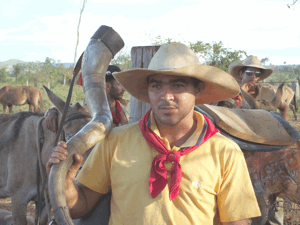
The behanche is an instrument made from a steer’s horn, used to draw the cows together. (Photo: Bobby Bascomb)
CURWOOD: From the Jennifer and Ted Stanley studios in Somerville, Massachusetts this is Living on Earth. I’m Steve Curwood. Climate scientists estimate the destruction of the planet’s tropical forests emit as much greenhouse gases each year as all forms of transportation combined. The Amazon of Brazil is the largest remaining tropical forest. So far the billions spent on conservation and law enforcement have failed to keep an area the size of France from being cut down, and deforestation continues.
Some say the least expensive, fastest way to preserve what’s left of the world’s tropical forest is to change incentives with a mechanism known as REDD. Reducing Emissions from Deforestation and Degradation is simple in principle: make it more profitable to keep the forest standing than cut down. Simple perhaps but not easy, as Living On Earth’s Bobby Bascomb and Bruce Gellerman found as they journeyed to Brazil in search of the REDD Path for a Green Planet.
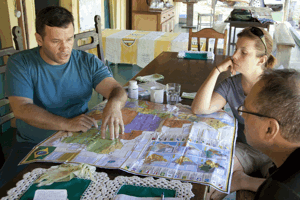
Marco Lima, Bobby Bascomb, and Bruce Gellerman mapping out their trip through the Amazon. (Photo: Lauren Oaks)
[ROAD SOUNDS]
GELLERMAN: Bobby and I spent a month traveling through the Amazon.
BASCOMB: We drove 5,000 long, dusty miles.
GELLERMAN: We just passed a sign that said Porto Vehlo: 1029 kilometers.
LIMA: Yep.
GELLERMAN: And that’s – that’s where we’re going.
LIMA: Yes, sir, that’s how much we need to do.
BASCOMB: That’s Marco. Marco Lima, our guide and driver. He’s short, stocky and fills out his safari shirt. Marco came with all the right credentials: he’s a fish biologist, jungle survival-combat vet, and a gifted gabber.
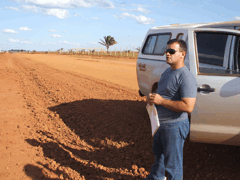
Marco Lima stands in front of our truck on the Trans-Amazon Highway. He was our interpreter, naturalist guide, and driver for 5 weeks and 5,000 miles across the Amazon. (Photo: Bobby Bascomb)
LIMA: …who told me we have enough forest and I disagreed.
[SOUNDS OF TRUCK ON ROAD]
GELLERMAN: Marco picked us up in the special truck he uses for trips through the jungle. It’s a heavy-duty suspension job with dual fuel tanks, and just in case, Marco put a machete under the driver’s seat.
BASCOMB: Get stuck out here in the Amazon frontier and you’re in trouble.
LIMA: If you look into this vegetation, what you can see that – watch out Bobby.
[FIRE CRACKLING SOUNDS]
GELLERMAN: Wow did you see that? It just leapt over there.
[FIRE CRACKLING]

After a rancher buys a piece of land he sells the valuable logs and burn what remains to improve the quality of the soil. This fire started on the side of the road in a previously cleared pasture of cattle grass. (Photo: Bobby Bascomb)
GELLERMAN: Fire. The side of the road is ablaze. We’re hundreds of miles south of the dense Amazon jungle driving through scrub savannah grasslands, and fire season is still a month away, but the place is a tinderbox.
LIMA: It sounds like crazy, Bruce, but a fire like this, if in the years we have less rain intensity this could burn the whole Amazon.
BASCOMB: So nobody will come along to put this fire out?
LIMA: No, this fire is waiting for the next rain.
BASCOMB: It could be a long wait. These days there’s less rain in the rain forest because there’s less forest. Scientists say deforestation is drying the Amazon. The rainy season comes later than it used to, and fires have become more intense.
GELLERMAN: The fires are usually set by settlers and speculators who slash and burn the trees to clear the land for logs and agriculture. In this part of the Amazon, an acre of forested land goes for about 175 dollars. Cleared of trees that same acre sells for about 12 hundred. It’s a no brainer – deforestation pays.
[STREET SOUNDS]
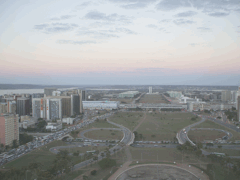
Brasilia, the capitol of Brazil, is a new city built just 40 years ago. It was designed with wide multi-lane streets and cement buildings. The Brazilian government moved the capitol from the coast to the interior to encourage people to settle the frontier. (Photo: Bobby Bascomb)
BASCOMB: The city of Brasilia is a product of that deforestation. In the 1960’s the government built a new capitol here. To spur development of the region they built a concrete jungle at the edge of the Amazon forest. It’s here in Brasilia that we met Paulo Moutinho.
GELLERMAN: Paulo Moutinho studies Amazon ants but these he days spends most of his time as Director of the Climate Change Program at IPAM – the Amazon Institute for Environmental Research. According to Moutniho, Brazil is the world’s fourth largest producer of greenhouse gases. And what’s really amazing is that three quarters of those emissions come from the deliberate destruction of the Amazon.
MOUTINHO: It’s like a container – a huge container of carbon – if you open that and cut trees, burning trees you produce a huge amount of emission of carbon, producing more global warming.
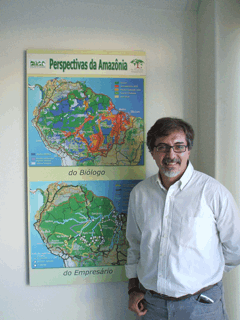
Dr. Paulo Moutinho is director of IPAM, The Amazon Institute for Environmental Research. (Photo: Bobby Bascomb)
GELLERMAN: So, the trees store a lot of carbon and you want to keep it in the trees.
MOUTINHO: Exactly. Without Amazon forest you have a big problem in terms of climate change.
GELLERMAN: Twenty percent of the Amazon is already gone but still locked within the trees is the equivalent of 50 years of US carbon dioxide emissions. Keeping all that carbon in the trees will take big bucks: tens, maybe hundreds of billions of dollars. To raise it, Moutinho advocates REDD, Reducing Emissions from Deforestation and Degradation. He says REDD is a way to make money from trees without cutting them down.
MOUNTINHO: I think that we need economic mechanism to save a large portion of tropical forest. We’re talking about area equivalent of all Europe.
GELLERMAN: There are many shades of REDD and ways to fund it. Moutinho favors a market mechanism. Money to save the forest would come from selling carbon credits to companies and countries that need to offset their climate disrupting emissions.
BASCOMB: Brazil’s president Luiz Inacio Lula de Silva wants to take a different road to REDD. Lula’s REDD program is funded by contributions. He wants polluting nations to donate 21 billion dollars to what he calls The Amazon Fund. There would be limited private carbon trading, most of the money would be controlled by the government.
They’d use the funds to monitor and preserve the forest.
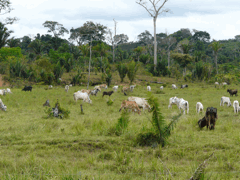
80 percent of deforestation in the Amazon is a result of raising cattle. (Photo: Bruce Gellerman)
BASCOMB: Alberto Lourenco works for Lula. He’s Assistant Secretary of Sustainable Development and in charge of The Amazon Fund.
LOURENCO: REDD could be important piece of many-sided solution to deforestation and to sustainable development in the Amazon. But so far it’s not – we are just beginning to experiment with REDD. You know the numbers are not even close to the amount of money that is supplied to pequaristas to cattle ranchers in the Amazon.
BASCOMB: Out of the 21 billion dollars Lula’s Amazon Fund hopes to collect just 118 million dollars in donations have come in. And not a single penny has been spent.
Meanwhile, Brazil spends 600 million dollars a year to expand agriculture into the Amazon forest.
GELLERMAN: Much of the money goes to a few huge Brazilian cattle ranchers to satisfy the world’s soaring appetite for beef. In the last ten years per capita consumption of beef has more than doubled in China. And in the last 15 years here in Brazil, beef consumption has tripled.
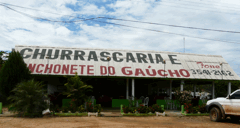
Most towns in Brazil have at least 1 churrascaria restaurant. (Photo: Bruce Gellerman)
[SOUNDS OF VOICES TALKING]
GELLERMAN: Brazilians love barbeque – Churasscaria is a cultural institution.
[SHARPENING OF KNIVES]
GELLERMAN: At Chursasscaria Bufalo in the Amazon city of Manaus, waiters carry long skewers of meat and sharp knives. You can eat as much as you want from any one of 29 different cuts of beef.
MAN: [Translation] Our people really love grilled food, and of course, as beef is very cheap food that’s why it really became part of our daily diet.
GELLERMAN: So you eat beef every day.
MAN: [Translation] Almost every day. On my day off I eat fish [Laughs].
GELLERMAN: There are people that say that beef is a problem because it causes environmental concerns. What do you think of that?
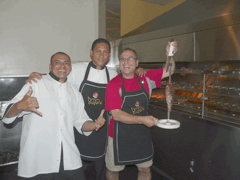
Bruce Gellerman with churrascaria waiters. (Photo: Bobby Bascomb)
MAN: [Translation] It is true, I agree, but it is not a major fact for the deforestation. I think the reason for the big deforestation are definitely the big logging companies.
BASCOMB: Logging used to be the driving force of Amazon deforestation, but in the 1990’s things changed dramatically.
[CATTLE BELL SOUNDS]
BASCOMB: Today, cattle is driving deforestation. The Amazon is rapidly being turned into ranch land.
[ROAD SOUNDS; COW BELLS; COW MOO-ING; HORNS]
BASCOMB: It’s rush hour Trans-Amazon style. We’re stuck behind nine cowboys on horseback and a thousand head of cattle. The cowboys are driving the cattle down the middle of the road in the Amazon state of Para.
[MAN YELLING]
BASCOMB: They use a dog and a behanche, made from a steer’s horn, to keep the herd together.
[HORN SOUNDS; BELL SOUNDS]

The behanche is an instrument made from a steer’s horn, used to draw the cows together. (Photo: Bobby Bascomb)
BASCOMB: Para is nearly twice the size of Texas and what was once dense forest is now cow pasture. Over the past 20 years, the number of cattle in the Brazilian Amazon has quadrupled. Today, 80 percent of the deforested land in the Amazon is used to raise and graze cows. The deforested area is the size of Japan.
[HORNS AND MOOING SOUNDS]
GELLERMAN: The cows are mostly Nelore – bred to survive the intense Amazon climate. The cowboys are also a breed apart; taciturn and tough.
[REPEATED HORN SOUNDS]
GELLERMAN: They’re driving this herd from a pasture in the northern Amazon to a ranch 700 miles to the south.
[HORN SOUNDS CONTINUE]
GELLERMAN: And how long will it take you to transfer the cattle from where you started to where you are going?
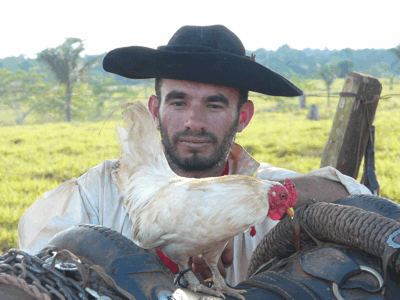
The Amazon cowboys use a rooster as their alarm clock. (Photo: Bobby Bascomb)
MAN:[Translation] Around 70 days.
GELLERMAN: You’re going to be in the saddle 70 days? That’s like the old west. That’s unbelievable.
MAN: [Translation] Welcome to the North – that’s how we manage our life.
[COW BELLS]
GELLERMAN: But life in the Amazon could soon change. Within a decade, Brazil plans to intensify beef production in the region and double it’s share of the international market. And at the same time the government wants to reduce deforestation in the Amazon by about 40 percent.
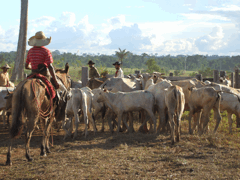
Once dense rainforest, the cowboys move this herd past farmer’s fields and through communities built on the Trans-Amazon. (Photo: Bobby Bascomb)
BASCOMB: But that’s not good enough for Greenpeace Brazil. The environmental group says the goal should be zero deforestation. Their report called “Slaughtering the Amazon” focused attention on the link between the cattle industry and destruction of the forest. Even Greenpeace was surprised by the news media’s reaction.
[WOMAN SPEAKING PORTUGUESE ON BRAZILIAN NEWS SEGMENT]
Ana Maria Braga video about cattle and deforestation
BASCOMB: Brazil's leading morning talk show aired a ten-minute story based on the Greenpeace investigation.
[NEWS SEGMENT CONTINUES]
BRITO: That hit the note with the Brazilian consumers.
BASCOMB: Kiko Brito is a spokesman for Greenpeace Brazil. The report, “Slaughtering the Amazon” spread like wild fire and reads like an indictment. It charges the Brazilian government with financing the destruction of the forest with billions of dollars in loan guarantees to cattle ranchers. And it provides detailed evidence linking international companies to the deforestation of the Amazon. The report tracks their purchase of leather and beef from illegally deforested land.
BASCOMB: Kiko Brito says “Slaughtering the Amazon” names names:
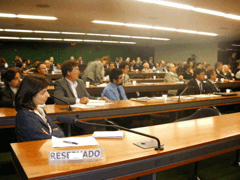
Government representatives from all over Brazil meet to discuss the Greenpeace report, “Slaughtering the Amazon.” (Photo: Bruce Gellerman)
BRITO: Adidas, Nike, Gucci. As we say in Brazil, this was the first report that gave name to the ox. In other words, we put the names behind the use of cattle to deforest the Amazon.
GELLERMAN: Word of the Greenpeace report hit the Brazilian cattle industry where it hurts: the consumer. Within days, Adidas, Nike, Gucci and the three largest supermarkets in Brazil had heard enough. They announced a moratorium, promising not to buy products produced from cows raised on illegally deforested Amazon land.
BRITO: When a supermarket says it will no longer buy meat from deforested areas it's not doing it because it is a nice supermarket, but because they heard something from people who are buying from their shelves.
[VOICE YELLING IN PORTUGUESE]
GELLERMAN: Greenpeace also heard something: angry congressmen from Amazonian states.
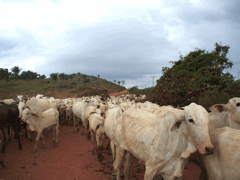
Cowboys use the Trans-Amazon highway to drive the cattle herd. (Photo: Bruce Gellerman)
BASCOMB: Brazil’s Chamber of Deputies held a special hearing after Greenpeace released its report.
[MAN YELLING]
BASCOMB: One member of congress shouted, “take Greenpeace out in handcuffs.” Another demanded Greenpeace accept economic reality.
CONGRESSMAN: [Translation] Yes, the Amazon is important but what are you going to do with the 25 million people living there?
[MAN YELLING CONTINUES]
GELLERMAN: Greenpeace organizers were visibly shaken by the angry response they got in congress. And even wondered if it was safe to meet with cattle ranchers in the Amazon the next day. According to Joao Talocchi of Greenpeace the group often receives death threats so organizers drive in armored vehicles.
TALLOCCHI: For more than 400 murders that happen in the Amazon. Not even one is arrested. So, there’s no governance, there’s no law enforcement in the Amazon right now.
Related links:
- Greenpeace Brazil
- IPAM
- UN REDD Program
- Greenpeace Report “Slaughtering the Amazon”
[MUSIC: Suba “Nightly Sins” from ‘Tributo’ (Six Degrees - 2002)]
CURWOOD: When we return – an environmental swat team tracks down illegal ranchers – and an alliance of cattle ranchers try to enforce the laws of the jungle. You’re listening to a Living on Earth special report: REDD Path to a Green Planet – stick around.
Carrots and Sticks: Saving the Amazon and Stalling Climate Change
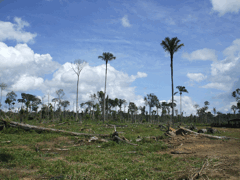
(Photo: Bobby Bascomb)
CURWOOD: It’s Living on Earth. I’m Steve Curwood. And our special report “REDD Path to A Green Planet” continues in Brazil’s Amazon.”
[JUNGLE AND ANIMAL SOUNDS]
CURWOOD: The peaceful sounds of the Amazon forest at dusk can be deceptive.
[JUNGLE SOUNDS CONTINUE]
CURWOOD: The Amazon is a dangerous place, especially for environmentalists, and especially in the remote northern state of Para. It’s here, that American nun Dorothy Stang lived and worked for 30 years, helping landless poor farmers, and fighting against illegal loggers and cattle ranchers.
STANG: We’re going to protect it so no loggers, or ranchers can ever make anything out of this area that would be detrimental to the biodiversity.
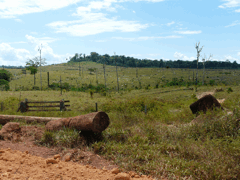
A clear line separates forest from farmland. (Photo: Bruce Gellerman)
CURWOOD: In 2005 Sister Dorothy Stang was murdered, shot point-blank 6 times by hired assassins. She’s one of the hundreds of environmentalists in Para who have been killed over the past few decades. The REDD mechanism – Reducing Emissions from Deforestation and Degradation – is designed to increase the value of the standing forest. If it is to have any hope of succeeding in the world’s largest tropical forest, it will have to work in a place where murder is a way of life in the struggle over the land. We rejoin Living on Earth’s Bruce Gellerman and Bobby Bascomb as they journey to one of the most dangerous parts of Para with an environmental SWAT team.
GELLERMAN: Officially, the region’s known as the “legal Amazon” but law enforcement never really followed the millions of settlers who were encouraged to move here in the 1970s. The military government promised land titles and law enforcement to poor migrants, but delivered neither.
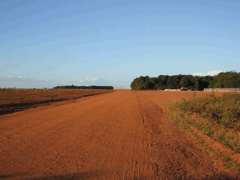
Most roads through the Amazon remain unpaved. (Photo: Bobby Bascomb)
BASCOMB: As we found out, this vast frontier is a lawless, often violent place. We met David Lourenco, a senior official in Brazil's Ministry of Strategic Affairs. He says, today Brazil is still trying to bring the Amazon under federal control.
LOURENCO: It's an unplanned dynamic resulting in chaos and conflict and violence and deforestation. The Amazon is by far the leader in deaths related to the struggle for land. It’s always a problem. The capacity to enforce rules, laws and policies in the Amazon is very low.
BASCOMB: We learned first hand that the long arm of the law doesn’t reach far into the Amazon.
[MAN SPEAKING PORTUGUESE]
BASCOMB: When we visited Brazil's environmental law enforcement agency we were told it has little money – only four helicopters and 400 armed agents to patrol an area the size of the continental United States.
EVARISTO: Es muy grande heh?
GELLERMAN: Luciano Evaristo points to a wall size map of the Amazon in his office. The Amazon is huge, yes, he says:
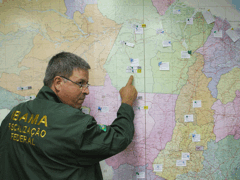
Luciano Evaristo stands in front of a wall-size map to point out areas where IBAMA, Brazil's federal environmental law enforcement agency, has conducted raids of illegal logging and ranching. (Photo: Bobby Bascomb)
EVARISTO: Post at cinco million quadras…
GELLERMAN: Evaristo is head of law enforcement at IBAMA, Brazil’s EPA. He flashes his badge and pulls out his gun, and proudly puts on his jungle combat jacket, which still has the tags on it.
[MAN SPEAKING PORTUGUESE]
GELLERMAN: On his map are 300 pushpins. Each one marks the places where IBAMA agents conducted raids last year. Most against heavily armed illegal loggers and ranchers.
EVARISTO: [Translation] A lot of times we get shot at, and we fire back. The problem is especially bad in the Amazon state of Para.
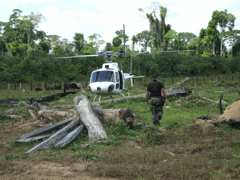
Federal IBAMA agents checking out an illegal cattle ranch. (Forest Bruce Gellerman)
GELLERMAN: Can we go to one of your busts?
EVARISTO: [Translation] Yes, you just need to choose which one. Do you have a bulletproof vest?
BASCOMB: Will you give us one?
EVARISTO: [Translation] [Laughs] Do you have life insurance? [Laughs]
GELLERMAN: Maybe I won’t go.
EVARISTO: [Translation] If we go you go.
GELLERMAN: They went…so we went.
[SLAMMING DOOR; MAN SAYING “VAMOS…ALRIGHT, LET’S GO]
GELLERMAN: We drove 500 miles on the Trans Amazon to the town of Novo Progresso – a backwater in Western Para. IBAMA has a brand new office here because residents of the town burned the last one to the ground along with the federal agents’ trucks. Logging and ranching are the lifeblood of the economy here. Environmental police aren’t welcome.
[HELICOPTER SOUNDS]
GELLERMAN: A helicopter arrives with senior IBAMA commanders. They’ve assembled a team of about a dozen federal agents from around Brazil. The agents will only stay here for about three months and keep to themselves so they don’t become targets for assassins.

The first IBAMA raid of illegal ranching was inside a national park. (Photo: Bobby Bascomb)
BASCOMB: A dozen more state and local police join this raid, they call it “Operation Minotaur,” named for the mythic Greek creature that has the head of a bull and the body of a man. The commandos carry pistols, automatic weapons, and pump action shotguns. Many wear bulletproof vests, but not us.
[HELICOPTER SOUNDS CONTINUE]
BASCOMB: The helicopter leads the way. Bruce, Marco our guide, and I follow in a truck convoy.
[ROAD AND TRUCK SOUNDS]
GELLERMAN: So, Bobby, what do you think?
BASCOMB: What do I think? I don’t know what to think. I don’t know quite what to expect from today. We thought it was just going to be a reconnaissance trip – as it turns out this is the actual bust. This is the real thing, so, ummm….
GELLERMAN: Are you scared?
BASCOMB: No, not really. I don’t know why I’m not. I should be. But I don’t feel scared for some reason. Are you? Are you scared?
GELLERMAN: No, but I don’t know what to expect.
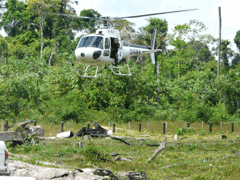
An IBAMA helicopter lands to raid an illegal cattle ranch inside a national park. (Photo: Bruce Gellerman)
BASCOMB: Yeah. That’s the worst part is the not knowing – not knowing what to expect, but maybe its better that way.
LIMA: Remember that this area is where the fire burns higher.
GELLERMAN: What do you mean?
LIMA: It’s the most dangerous area of Brazil right now – land grabbing, it’s right here. We are here in the middle of the fire.
BASCOMB: So should we be scared?
LIMA: Yeah, we have to be very careful.
GELLERMAN: Now I’m scared.
BASCOMB: Yeah, right.
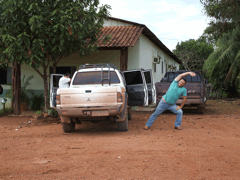
Guide and interpreter Marco Lima stretches to get ready for a long day of driving the unpaved Trans-Amazon highway. (Photo: Bobby Bascomb)
BASCOMB: We drive for hours along the Trans Amazon finally turning onto a path bulldozed through what's left of the jungle. Satellite photos confirm a tipster's report that there are nearly 45 thousand head of cattle being illegally raised here.
GELLERMAN: Remarkably, this is the middle of a national park. What remains of the rainforest is a haunting sight; charred skeletons of trees slashed and burned, their gnarled limbs reach skyward, leafless and lifeless.
GELLERMAN: Look at that – it’s really devastated, they really wacked the forest here.
LIMA: Yeah, we’re talking about at least in this area where we can see two to two and a half thousand acres of open cleared land. Probably, Bruce, this was a big fire – one big, solid fire.
[TRUCK SOUNDS ON ROAD]
LIMA: It looks like It’s been heavily bombed.
GELLERMAN: So Marco, we see motorcycles here. They know were coming don’t they?
LIMA: Well, yeah. In this area when they see IBAMA they say, ‘There come the man. There comes the guys.’ Because IBAMA here they know it’s big trouble for them. It’s really big trouble.
[TRUCK SLOWS; CAR DOORS OPEN]
BASCOMB: Finally, we arrive at a ranch but nobody's home. A pot of coffee on the stove is still warm. Seems the only thing missing is a welcome mat.
[WALKIE-TALKIE SOUNDS]
BASCOMB: The IBAMA agents search the place, but they come up empty handed.

A ranch house, complete with fences and a satellite dish illegally located inside a national park. (Photo: Bobby Bascomb)
GELLERMAN: Look at this guy, he’s got a ranch house, he’s got a satellite dish. He’s got beautiful fences. I mean he’s not trying to hide from you; he’s pretty darn obvious.
[MAN SPEAKING PORTUGUESE]
VOICEOVER: They think just because IBAMA doesn't have a fixed base they think we'll never go after them but we will.
[HELICOPTER SOUNDS; WALKIE TALKIE SOUNDS]
GELLERMAN: It was the same scene three hours later at another ranch in the national forest. Again: nobody home.
[VOICES TALKING; GRUNTING NOISE]
GELLERMAN: But this time the IBAMA agents disable a tractor.
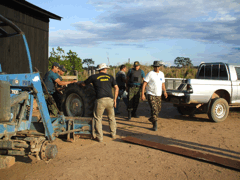
Federal environmental law enforcement agents disable a tractor by removing its tires. (Photo: Bobby Bascomb)
[GRUNT]
GELLERMAN: Removed the tires
[GRUNT]
GELLERMAN: And hauled them away.
[CLUNK OF TIRE IN TRUCK]
GELLERMAN: Exhausted and frustrated, the IBAMA agents say they’re not defeated. They say they’ll return another day to arrest the rancher.
BASCOMB: Last year, IBAMA agents confiscated 400 trucks and tractors in the Amazon from illegal loggers and ranchers. And they confiscated eight million cubic feet of wood. But we soon learn that enforcing environmental law in the Amazon can have unforeseen consequences.
[MILL SOUNDS]
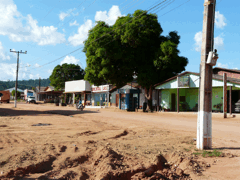
Many people in the town of Caracoal are out of work since IBAMA agents shut down the illegal lumber mill. (Photo: Bruce Gellerman)
BASCOMB: The next day, we got a flat tire in the remote town of Caracol. The owner of the vacant hotel and restaurant offers to sell us the entire town. Nine months earlier IBAMA agents busted Caracol’s lumber mill and the community has been out of work since.
GELLERMAN: At the abandoned mill, a young man carrying a baby steps over scraps of hardwood.
GELLERMAN: Can I as you a couple of questions?
[MAN SAYING “NO, NO”]
GELLERMAN: But the man doesn’t want to talk.
GELLERMAN: So nobody is working here…
GELLERMAN: He’s afraid.
GELLERMAN: So, what do people do here for a living?
MAN: [Translation] They fish little fish otherwise they will starve.
GELLERMAN: So what do you make of this place?
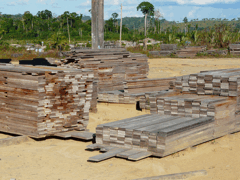
IBAMA agents recently closed down the lumber mill in the town of Caracoal, Para. (Photo: Bruce Gellerman)
LIMA: This is one of the several lumber mills that IBAMA and all the other government agencies – they stopped the environmental impact and started the social impact. They maybe have here at least 80 families with no income. Someone is paying the price, and the price that we see here for the preservation is poverty.
BASCOMB: Stepped up enforcement of environmental laws is part of the reason deforestation in the Amazon is down to the lowest level in two decades.
GELLERMAN: But Amazon cattle rancher John Carter says, there’s got to be a better way.
CARTER: The trick to conservation in the Amazon is to get greed and harness that greed. Make that force focus on keeping the forest standing.
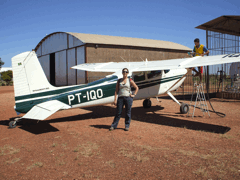
Producer Bobby Bascomb getting ready to take off in John Carter’s Cessna. (Photo: Bruce Gellerman)
GELLERMAN: John Carter is a horseback ridin’, tobacco chewin’, rootin ’tootin cowboy from San Antonio, Texas. 14 years ago, after serving as paratrooper in Iraq, Carter married a Brazilian woman and moved here.
[PLANE SOUNDS]
GELLERMAN: To a remote corner of the southeastern Amazon. These days Carter spends more time in his single engine Cessna than the saddle.
CARTER: I came down chasing a dream. It had nothing to do with making money or financial reasons - it was strictly to live a life of adventure and frontier.
GELLERMAN: John Carter’s wife comes from a wealthy, influential family. Her grandfather introduced the breed of cattle that’s raised in the Amazon.
[PLANE RADIO SOUNDS]
GELLERMAN: With backing from his father-in-law, Carter started a 12 thousand acre ranch along the Amazon frontier in the state of Mato Grosso.
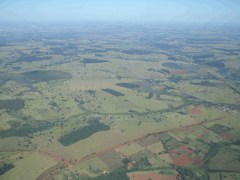
The view of agricultural land in the State of Mato Grosso from John Carter’s plane. (Photo: Bobby Bascomb)
CARTER: That’s Agua Boa due west of us. That was a small teeny-weenie little town when I first moved here. This area had very small cattle numbers at that time. Today as a result of expanding landmass they’ve opened land, because of deforestation this is the largest cattle auction in the world. It’s in the Guinness book of records.
[AIRPLANE SOUNDS FADE; PARADE SOUNDS AND MUSIC]
BASCOMB: Marching bands commemorate the 30th anniversary of the city of Agua Boa. The boomtown lies in the geographic heart of Brazil at the center of cow country. The place is perfect for agriculture: flat as Kansas but four times as large. What was once a forested frontier is now on the cutting edge of Brazil’s future, and fertile territory for John Carter and his Allianca de Terra – the Land Alliance.
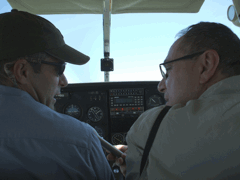
Living on Earth’s Bruce Gellerman interviews cattle rancher John Carter as he pilots his Cessna over Mato Grosso farmland. (Photo: Bobby Bascomb)
[DRIVING SOUNDS]
CARTER: Look over here, off to the east over here at around 11:00 all that's our forest reserve.
BASCOMB: Carter drives us around his ranch. In this part of the Amazon, you’re supposed to keep half your land forested, but few follow the law. When Carter bought the place he decided to let 22 hundred acres regrow. He says that choice cost him more than a million dollars in lost productivity.
CARTER: And I let it come back to forest to come into compliance with the forest code.
BASCOMB: Do you regret doing that?
CARTER: I don't regret it, no. Personally I don't, but it was not a very wise decision. I don't get paid anything. I should be getting paid carbon credits for that. Two to three tons a year per hectare that's sequestering – that's a pretty good revenue stream for the ranch.
BASCOMB: The experience made John Carter one of the biggest cheerleaders for a REDD mechanism in Brazil. He founded the Land Alliance, and after convincing ranchers he wasn’t a CIA agent, signed up 160 Amazon farmers proving they could do better financially by doing good environmentally.
CARTER: We want to create mechanisms that puts a carrot out in front of the producer instead of a gun barrel behind his head.
BASCOMB: Since cattle are the force driving deforestation in the Amazon the Land Alliance hopes to put consumers in the driver’s seat.
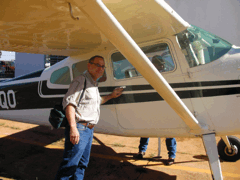
Living on Earth’s Bruce Gellerman boards John Carter’s Cessna. (Photo: Bobby Bascomb)
GELLERMAN: Carter’s Land Alliance is creating a premium brand of beef, guaranteed not to come from deforested land, for which consumers would pay a premium price. In effect, a REDD mechanism for red meat. His organization has devised a vigorous certification system for member farmers.
CARTER: So he’s coming into our system, he’s taking off his clothes basically, he’s showing us his body and all the defects, and he’s allowing us to tell him what he needs to do to come back into compliance.
GELLERMAN: So the idea is to make the value of a standing forest more valuable than if you were going to cut it down and use if for cattle, soy beans, and so on?
CARTER: Absolutely. Our goal, hands down, is to buy time. More importantly, is that long-term goal, like you said, to make the standing forest at least almost comparable valuable to the cleared forest. If it’s 30 percent as valuable as the cleared forest, we’re gonna have a tremendous impact. Doesn't have to be one to one. People sense that there’s a lot of goodwill and a lot of people that are willing to create a new model.
[BIRD SOUNDS]
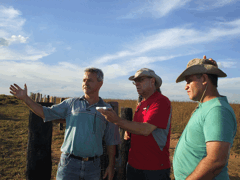
Living on Earth’s Bruce Gellerman interviews soy farmer Jamar Brunier (left) and Marco Lima translates (right). (Photo: Bobby Bascomb)
GELLERMAN: Jamar Brunier is one of those people. Recently, Brunier joined Carter’s Land Alliance. 20 years ago, he and his wife migrated from the south of Brazil to Mato Grosso. They came with one suitcase each and a shared dream. Today, they own a grainery and 65 hundred acres of land.
BRUNIER: [Translation] When I bought this land I didn’t have any information from anyone. I simply came with a Caterpillar and we cleared everything here. Come look down here.
[WALKING SOUNDS]
BRUNIER: [Translation] We simply cut, chopped down everything all the way to the riverbanks.
GELLERMAN: Land Alliance evaluators scrutinized satellite photos and visited Brunier’s farm. They found he had destroyed a thousand acres too much. They gave Brunier a report detailing what need to be done and the technical expertise to come into compliance. More carrot, less stick.
BRUNIER: [Translation] Now with the help of the alliance they came here and told us what to do and before the government comes here and fine me, I’m going to start to replant with the original woods from here. I will do the reforestry.
GELLERMAN: Would you have known that without the Land Alliance?
BRUNIER: [Translation] No, I was going to be fined by the government such a fine that I would never have money to pay. I was going to go bankrupt.
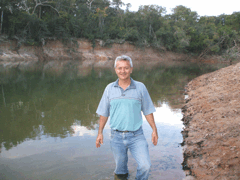
Farmer Jamar Brunier stands in a river that runs through his property. When colonists first settled the frontier the Brazilian government encouraged them to deforest all the river banks to reduce malaria. Now Land Alliance farmers like Jamar Brunier are reforesting riparian zones. (Photo: Bobby Bascomb)
[BIRD SOUNDS]
GELLERMAN: But these days it’s not the government that worries farmer Jamar Brunier the most – it’s a non-governmental organization: Greenpeace. The NGO’s scathing report “Slaughtering the Amazon” blames farmers like Brunier for destroying the forest.
BRUNIER: [Translation] If NGO’s come here to accuse us, what are they going to do? We’ve been doing things right. I will tell Greenpeace my water is clean.
GELLERMAN: What would you like to tell Greenpeace?
BRUNIER: [Translation] I really want to tell the guys from Greenpeace that they need to know from where the food come from – from where the butter comes from, where the food their kids eat comes from. And I cry because no one comes to hear us what we want to say. They only come here to spank us. That’s why I’m crying.
BRUNIER: [Translation] Our intentions are good.
GELLERMAN: Says Amazon farmer Jamar Brunier.
[MUSIC: Jose DaLouis Alenca was recorded on location in Para Brazil by the LOE producers.]
CURWOOD: This song about the Amazon forest was composed and sung by one of the Federal environmental agents who took Bruce and Bobby along on the raids of illegal ranches.
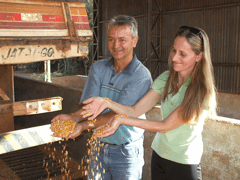
Jamar Brunier and his wife proudly display part of their harvest of corn. (Photo: Bobby Bascomb)
[ALENCA SINGING SONG IN PORTUGUESE]
CURWOOD: It’s really a beautiful song, but I don’t speak Portuguese. Bobby, Bruce – what does it say?
GELLERMAN: Well, it’s a really sad song, as you can hear. It’s about destruction of the Amazon forest, and the song is named after a town and bird in the forest.
BASCOMB: Right, that’s Jose Da Louis Alenca. He’s the federal agent who wrote this song, and he came by our hotel room after a long day with the SWAT team and brought his guitar along.
CURWOOD: So the song is about a town and the forest. It sounds a lot like the place you went to where you met the young man who hadn’t worked for some nine months after the Brazilian feds had shut down the town’s illegal log mill?
GELLERMAN: Yeah, they shut down the town. It really does bring into stark contrast when you’re talking about preserving the forest and mechanism like REDD, you also need to think about the millions of people – most of whom are poor, Steve – who live in the Amazon and how efforts to keep the forest standing are going to affect them.
CURWOOD: So for REDD to work it’s not just a matter of raising the money to pay for it, or monitoring the forest, but figuring out who gets this dough and what they do with it.
BASCOMB: Exactly, Steve. And as we found out REDD will also have to deal with the indigenous people who live in the Amazon and have been protecting it for thousands of years. They still control a huge part of the forest.
CURWOOD: Well, we’ll be listening.
Related links:
- Mongabay
- The Land Alliance
Protecting a Forest and Preserving a Culture
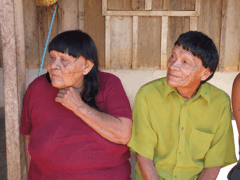
Chief Almir’s parents are the last generation with traditional tribal tattoos. The tradition ended after first contact with white settlers in 1969. (Photo: Bobby Bascomb)
CURWOOD: It’s Living on Earth. I’m Steve Curwood. The last stop on our REDD Path to a Green Planet takes Bruce Gellerman and Bobby Bascomb to a remote corner of the Amazon in Surui territory. The Surui are an ancient indigenous people who are pioneering a new forest management plan. It’s designed to rescue their culture, preserve their forest, and perhaps, just perhaps, help save the planet from catastrophic climate disruption.

After first contact with white settlers on September 7th, 1969, ninety percent of the Surui died from diseases. Today there are 1,300 members of the Surui living in 4 clans. (Photo: Bruce Gellerman)
[UNFOLDING MAP]
BASCOMB: Chief Almir Surui carefully unfolds a map and spreads it on a table. The Surui have been living here in the southwest Amazon for thousands of years, yet this map of their homeland is the first of its kind.
ALMIR: [Translation] If you look at every single spot, every single creek. What we did here is simply understand deep inside our wealth. Our people know what we have.
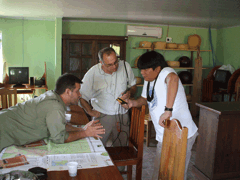
Chief Almir demonstrates the Surui’s GPS units to Bruce Gellerman and guide Marco Lima. (Photo: Bobby Bascomb)
GELLERMAN: The map shows where the Surui harvest cashews and other foods from the forest. And tiny symbols mark sites where shamans performed rituals and the Surui fought historic battles.
GELLERMAN: What is this, it looks like little huts.
ALMIR: [Translation] Powantigua is the place where was made the contact with the Surui people.
GELLERMAN: First contact with the Surui was September 7th 1969. That’s the day Brazilian government agents first approached the tribe. Settlers soon followed, stealing 80 percent of the Surui land and bringing new diseases that killed 90 percent of the people.
[MAP UNFOLDING SOUNDS]
BASCOMB: Today, the Surui are fighting back. We’re in the Surui business office in the small town of Cacoal. On a wall hangs a bow and arrow and a long, sharp spear.
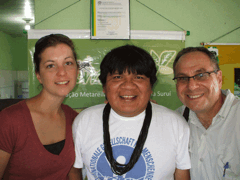
Bobby Bascomb, Almir Surui and Bruce Gellerman in the Surui business office in Cacoal, state of Rondonia, Brazil. (Photo: Marco Lima)
[TYPING ON COMPUTER]
BASCOMB: And on a conference table: a laptop. The Surui are now defending their land with computers, GPS units, and satellite images donated by the U.S.-based Amazon Conservation Team. The Surui used the technology to create this detailed map of their reserve.
ALMIR: [Translation] I'm going to show you now how we want to use technology to protect our territory.
[CLICKING SOUNDS ON COMPUTER]
BASCOMB: So, right now you’re using laptop to zoom in on – is that your house right there?
ALMIR: [Translation] Here you can see how much deforestation we have and also above here you can see the other indigenous territory. All the whites you can see, all the white spots, these are farms that have already destroyed the forest.
BASCOMB: To preserve what’s left of the forest and replant what’s been lost to settlers, Chief Almir has devised a 50-year management plan. It’s a pioneering Indigenous REDD project. The Surui hope to profit by protecting their 600 thousand acre forest and auction off the carbon stored in the trees.
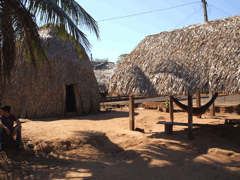
Except for the telephone pole this could have been a scene of a Surui village 1,000 years ago. (Photo: Bruce Gellerman)
GELLERMAN: They plan to sell the forest carbon as credits to companies and countries that want to offset their climate disrupting emissions. To verify their carbon inventory, the tribe uses images from orbiting satellites. In just two generations, the Surui have gone from the Stone Age to the Space Age.
GELLERMAN: You know it’s given you a whole different viewpoint on the world. When you show this to the people of your tribe – when you show these satellite pictures – what do they say?
ALMIR: [Translation] We thought that these images were something like coming from the eye of a monster who likes to eat forest, then we thought, well, maybe we can use the eyes of this monster to protect the forest.
[ROAD SOUNDS]
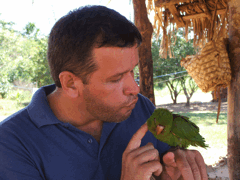
Translator, Marco Lima, speaks parrot with a fine feathered friend. (Photo: Bobby Bascomb)
BASCOMB: It’s 25 bone-jarring miles from Chief Almir ’s office to the Surui tribal village. Our guide, Marco, drives while we bounce around in the back. Almir sits in front.
GELLERMAN: We travel past fields that have been slashed for their hardwood and burned to make way for cattle ranches and soy farms. All that remains of what was once a dense rainforest are knee-high tree stumps, and bitter memories of first contact.
ALMIR: [Translation] We had to give up on our land to survive, to remain alive. I’m not against farms; I’m not against production. The only thing I’m really concerned that the white man should see is that they have to grow with sustainable responsibility.
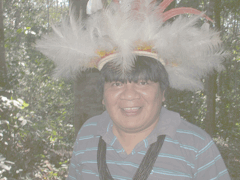
Chief Almir wearing a traditional Surui feather head dress and beads (Photo: Bruce Gellerman)
GELLERMAN: When you see this does it make your angry? Does it make you…?
ALMIR: [Translation] I get first of all sad because I really don’t know what happened to a guy like this who simply comes in and clears everything. I don’t know what goes on in his brain.
LIMA: Now we are we getting to the Surui people and as you can see the amazing difference of the vegetation of what you can see over there and what is in here – there you can see the cattle and over there you can see pristine forest.
GELLERMAN: The difference couldn’t be more dramatic: deforestation ends where Surui territory begins. Like a surgeon’s knife, the chain saws of illegal loggers have cut clean, separating dense Surui forest reserve from open farmland.
GELLERMAN: At a sharp bend in the road we see loggers leaning on dirt motorbikes and they see us. We get cold hard stares. I want to stop and talk to the loggers.
BASCOMB: But Almir says, oh, no, no, no. Keep going.
ALMIR: [Translation] Let's not stop. Let’s not stop. They’ll give us a hard time.
GELLERMAN: Why's that?
ALMIR: [Translation] They threat us because all this logging here is illegal. I was threatened so many times here.
BASCOMB: Really?

Surui teens spread coffee beans to dry in the sun. (Photo: Bruce Gellerman)
ALMIR: [Translation] It’s very dangerous.
BASCOMB: Over the past decade 11 tribal elders in the Amazon have been assassinated. Two were Surui. It was almost three: a few years ago someone tried to run Almir off this road. He was evacuated out of Brazil, and when he returned he was promised protection, but Almir says, that was a joke.
ALMIR: [Translation] The secret security they were supposed to take care of me it so secret that I’ve never seen it. [Laughs]
[TRUCK STOPS]
GELLERMAN: That’s quite a trip.
BASCOMB: Wasn’t as long as I’d thought it’d be.
GELLERMAN: We finally arrive at the Surui village. It’s a scattering of wood huts with palm-thatched roofs. The Surui sleep in rope hammocks and use wood to cook in open fire pits.
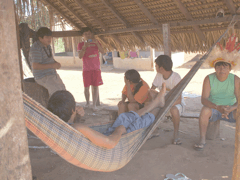
Surui men hang out in hammocks to escape the hot tropical sun. (Photo: Bruce Gellerman)
[VILLAGE AMBIENCE]
GELLERMAN: Bon jia…
GELLERMAN: Next to a vegetable garden are solar panels and where coffee beans dry: a satellite dish.
ALMIR: [Translation] Here is our tribe. And here you have my father my mother, my nephews, my brothers.
BASCOMB: The Surui have extended families, and elders are revered. Almir proudly introduces us to his father, the former chief of the tribe.
ALMIR: Marco, Brucy, Bobby.
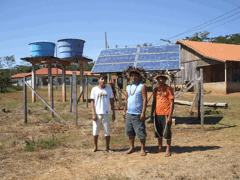
Surui teens show off the tribe’s solar panels. (Photo: Bruce Gellerman)
FATHER: Marco, eh?
ALMIR: Marco.
GELLERMAN: Bruce.
LIMA: Brucee…Bobby.
BASCOMB: Moto Brasie.
LIMA: He says his name is Marimope.
BASCOMB: Chief Marimope’s face is lined with tribal tattoos. His son, Chief Almir has none. The custom ended 40 years ago, after first contact with white settlers. Surui chiefs can have up to four wives. So far, Almir has two. He is the critical link bridging the tribe’s past with it’s future. Chief Almir is the first of the Surui to attend college. Still, tradition and lore guide his way.
ALMIR: [Translation] My father told us so many times about how he grabbed his bow and arrow and went to war.
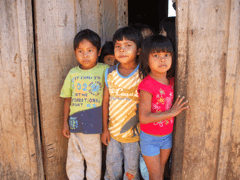
Curious children peek at us from their homes. (Photo: Bruce Gellerman)
GELLERMAN: Almir proudly retells the story of a time his father Chief Marimope defended the forest. Settlers had invaded Surui land and cut down their trees. Chief Marimope blocked the logging trucks.
[ALMIR SPEAKING PORTUGUESE]
GELLERMAN: When 200 Brazilian soldiers returned to claim the trucks and trees they surrounded the Surui. But Chief Marimope stood his ground.
ALMIR: [Translation] And he said to the commander, “Commander, I can even be killed, but you will die before I die.”
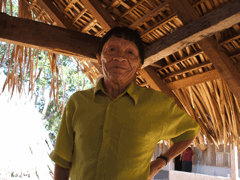
Chief Marimope is a legendary Surui warrior. He once stood his ground against 200 Brazilian soldiers who came to the tribe’s reserve to take logs cut from Surui land. (Photo: Bruce Gellerman)
ALMIR: [Translation] But you are the one that’s going to decide. You have family I also have family. Your family will be without you; my family will be without me. And my sister was translating for him – she was just a teenager, as you know my father doesn’t speak Portuguese. And the commander was like walking backwards, and then he fell on the ground. And then my father pointed bow and arrow to him and said, “Throw your gun away.” He said this commander said, “Okay, I’m sorry, friend, I apologize.” And father said, “No, no, no, friends don’t act like this to other friends; get out of here, get out of my place.” And the commander said to all his men, “for god sake don’t do anything to these guys, let’s get out of here.”
[CHOPPING SOUNDS]
GELLERMAN: The forest is sacred to the Surui. It’s essential for their existence and subsistence. The forest provides.
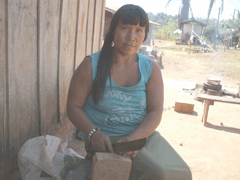
The forest provides: a young Surui woman chops nuts. They yield worms to eat and decorative jewelery. (Photo: Bruce Gellerman)
[CHOPPING SOUNDS CONTINUE]
GELLERMAN: A young woman sits on a low wood stool and with quick, sharp blows from her machete, cracks open nuts she’s gathered from the forest, saving the shells and what’s inside.
GELLERMAN: Oh my god, there’s worms. WORMS!
[WOMAN LAUGHS]
GELLERMAN: Hey, Bobby…take a close look at what she’s doing.
BASCOMB: Oh, those aren’t nuts, those are worms. What are they for? Are those for lunch? Para desauno, para comida?
WOMAN: Comida.
GELLERMAN: And then she’s cutting the shell, watch. She’s cuts the shell. Yeah, she’s cutting the beads, yeah, she’s making beads.
[CHOPPING SOUNDS]
BASCOMB: Ahhh.
[GRASS CRUNCHING; WALKING SOUNDS]
BASCOMB: It’s a short hike to the forest where the Surui gather these nuts. As we walk Chief Almir details his 50-year management plan. The tribe will continue to protect the forest as they’ve always done, and replant 18 thousand acres of trees illegal loggers cut down on Surui territory.
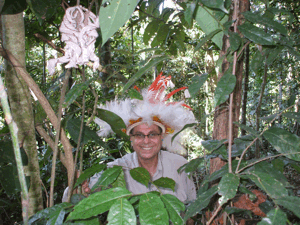
The surui were amused when Bruce tried on a traditional headdress. (Photo: Almir Surui)
GELLERMAN: All told, the tribe plans to grow a million new trees. So far, they’ve planted 80 thousand.
ALMIR: [Translation] I think what we should do is make this a forest again. Let area receive species that always belonged to here. Feel the air, smell this, so delicious.
[SOUNDS OF BREATHING AIR IN]
ALMIR: Not only through nose, but don’t you feel skin breathing?
GELLERMAN: Can you restore the forest to the condition that it was before it was destroyed?
ALMIR: [Translation] Yes, we definitely can. That’s why we are researching areas that are today pasture so we can through science understand what kind of species used to live here. And then we can apply to every area according to its needs.
[WALKING NOISES; ALMIR SPEAKING PORTUGUESE]

Chief Almir’s parents are the last generation with tribal tattoos. The tradition ended after first contact with white settlers in 1969. (Photo: Bobby Bascomb)
ALMIR: [Translation] This is a result of re-forestry already. This is also hardwood – mahogano – Brazilian cherry.
BASCOMB: Yeah, how did you choose these trees? Why these trees and not some other kind?
ALMIR: [Translation] The way we thought and planned was let’s replant the trees that suffered bigger impact. And we also choose fruit trees that can feed our people. And we also picked trees that have the importance on our rituals, things that really make a difference for our culture.
[WALKING NOISES]
ALMIR: [Translation] This plant was identified by the researchers. This is a medicinal plant – it is a very good anesthesiac for a toothache. We chew the leaf.
GELLERMAN: Hmmm. It’s a mint. Ah, it’s numbing. My tongue is totally numb. [Laughs]
ALMIR: This very good for toothaches and also for ant bites.
BASCOMB: Have you ever considered to market these?
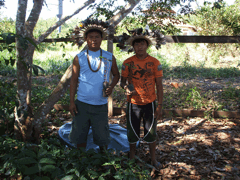
Surui teens hold seedlings for the reforestry project. (Photo: Bruce Gellerman)
ALMIR: [Translation] Yes, our main idea is to make use of the forest the way it is. Keeping it. Preserving it. Respecting the forest, using the forest the way it, first of all, is going to remain preserved, and then of course in a way it can also benefit not only us, but also the rest of the world.
[BIRD SOUNDS]
GELLERMAN: What is that?
ALMIR: [Translation] “Ah….they are coming,” that’s what they are saying.
[BIRD SOUNDS CONTINUE]
GELLERMAN: The Surui say when the Akaki bird’s sings it’s warning: that there are other people in the forest watching them. But Almir doesn’t need the Akaki to warn him. He knows he’s being watched by illegal loggers. But he has work to do in town. So he has us take a different road back so he can avoid their threatening stares.
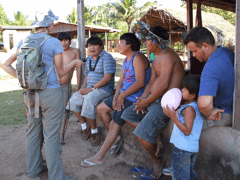
Bobby Bascomb interviews Chief Almir as he sits with his family (Photo: Bruce Gellerman)
[ROAD SOUNDS]
BASCOMB: To make sure their forest carbon deals are air tight, the Surui tribe has retained one of the world’s largest law firms, and Chief Almir has called upon Ivaneide Cardozo to ensure the REDD deal doesn’t turn into green washing. She is one of Almir’s two wives, and head of an NGO that helps indigenous people defend their land.
CARDOZO: [Translation] For the past three years we’ve been preparing a whole tribe the whole community to have a project and sell it.
[CARDOZE SPEAKING PORTUGUESE]
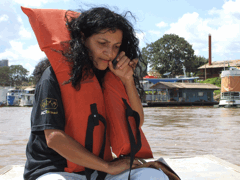
Ivaneide Cardozo is head of Kaninde, an indigenous environmental NGO. She is one of Chief Almir’s two wives and works on the Surui REDD project. (Photo: Bruce Gellerman)
CARDOZO: [Translation] The point is, are we going to sell to any company? We don’t want that. What we want to sell these rights to companies that want to protect the environment. Are we going to wash the faces of dirty companies? No. We’re not here only to sell, we are here to negotiate with people that are committed to the environment.
[CHIEF ALMIR’S MOTHER SPEAKING SURUI]
MOTHER: [Translation] I think it’s good for people from the outside to help repair this destroyed forest.
BASCOMB: That’s Chief Almir’s mother. She survived the diseases of first contact and endured the threats from illegal loggers. Now she puts her hopes in her son’s REDD forest project.
MOTHER: [Translation] It’s like we are giving, but also receiving. We do reforestry and this service will help mankind breathe better. I think help from international institutions is very important to Almir’s efforts. This needs to be a model for other indigenous groups and institutions.
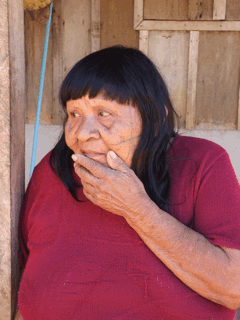
Elders like Chief Almir’s mother only speak their traditional language, Paite. They never learned to Portuguese, the language of the settlers. (Photo: Bobby Bascomb)
GELLERMAN: Indigenous people comprise less than three percent of Brazil’s population yet they control and protect a quarter of the Amazon forest. It’s the largest tropical forest left on the planet.
[VOICES TALKING; VILLAGE SOUNDS]
GELLERMAN: Almir, it seems to me, it just struck me – that what you’re doing here in this village in Brazil could change the world.
ALMIR: [Translation] What I need to do is try to make a better world. I don’t want to just be proud of it; I want to be contagious and have all other people coming with me, beside me, with the same idea. And bring to the world the hope of a new reality.
[BIRD SOUNDS]
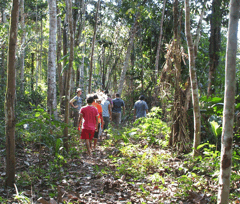
The Surui say that the Acaci bird warns of intruders in the forest. (Photo: Bruce Gellerman)
GELLERMAN: For a month, we traveled the reality that is today’s Amazon in search of how REDD might work. We drove five thousand miles over unpaved roads bulldozed through what’s left of the forest. We met politicians and environmentalists, cattle ranchers and farmers, indigenous people and scientists – all who seem to have the same good intentions: sustaining the forest while developing it. But REDD is an unproven method that will cost hundreds of billions of dollars, require complex systems to monitor. And if REDD is to work, and help stall climate disruption, it will also take a global society that appreciates just what’s at stake – and finds the will to act.
[BIRD SOUNDS]
BASCOMB: And high in the canopy of Brazil’s Amazon forest the Akaki bird watches and warns: time is running out.
[BIRD SOUNDS CONTINUE]
[MUSIC: Baden Powell “Estorias De Alcantara” from ‘Baden Powell: Three Originals’ (MPS Records - 1975)]
CURWOOD: Our story about Brazil’s Amazon was produced by Living on Earth’s Bruce Gellerman and Bobby Bascomb, with help from Marco Lima. It’s part of our ongoing series, REDD path to Green Planet. Next week, we travel to Copenhagen and report on the climate summit and visit Indonesia’s tropical forest to see how REDD could work there.
Related links:
- Ivaneide Cardozo's NGO Kaninde works with the Surui on the REDD forest project
- Indegenous Environmental Network Opposes the REDD Scheme
- Amazon Conservation Team
[MUSIC: Baden Powell “Estorias De Alcantara” from ‘Baden Powell: Three Originals’ (MPS Records - 1975)]
CURWOOD: Our story about Brazil’s Amazon was produced by Living on Earth’s Bruce Gellerman and Bobby Bascomb, with help from Marco Lima. It’s part of our ongoing series, REDD path to Green Planet. Next week, we travel to Copenhagen and report on the climate summit and visit Indonesia’s tropical forest to see how REDD could work there.
[MUSIC CONTINUES]
CURWOOD: Living on Earth is produced by the World Media Foundation. Our crew includes Eileen Bolinsky, Jeff Young, Helen Palmer, Ike Sriskanderajah, Mitra Taj, Ingrid Lobet, and Jessica Ilyse Smith, with help from Sarah Calkins, Marilyn Govoni and Sammy Souza. Our interns are Quincy Campbell and Nirja Parekh. Alison Lirish Dean composed our theme. Jeff Turton is our technical director. I’m Steve Curwood. Thanks for listening.
ANNOUNCER 1: Funding for Living On Earth comes from the National Science Foundation supporting coverage of emerging science. And, Stonyfield Farm, organic yogurt and smoothies. Stonyfield pays its farmers not to use artificial growth hormones on their cows. Details at Stonyfield dot com. Support also comes from you, our listeners. The Ford Foundation, The Town Creek Foundation, The Oak Foundation—supporting coverage of climate change and marine issues. The Bill and Melinda Gates foundation, dedicated to the idea that all people deserve the chance to live a healthy and productive life. Information at Gates foundation dot org. And Pax World Mutual Funds, socially and environmentally sustainable investing. Pax world for tomorrow. On the web at pax world dot com.
ANNOUNCER 2: PRI – Public Radio International.
Living on Earth wants to hear from you!
Living on Earth
62 Calef Highway, Suite 212
Lee, NH 03861
Telephone: 617-287-4121
E-mail: comments@loe.org
Newsletter [Click here]
Donate to Living on Earth!
Living on Earth is an independent media program and relies entirely on contributions from listeners and institutions supporting public service. Please donate now to preserve an independent environmental voice.
NewsletterLiving on Earth offers a weekly delivery of the show's rundown to your mailbox. Sign up for our newsletter today!
 Sailors For The Sea: Be the change you want to sea.
Sailors For The Sea: Be the change you want to sea.
 The Grantham Foundation for the Protection of the Environment: Committed to protecting and improving the health of the global environment.
The Grantham Foundation for the Protection of the Environment: Committed to protecting and improving the health of the global environment.
 Contribute to Living on Earth and receive, as our gift to you, an archival print of one of Mark Seth Lender's extraordinary wildlife photographs. Follow the link to see Mark's current collection of photographs.
Contribute to Living on Earth and receive, as our gift to you, an archival print of one of Mark Seth Lender's extraordinary wildlife photographs. Follow the link to see Mark's current collection of photographs.
 Buy a signed copy of Mark Seth Lender's book Smeagull the Seagull & support Living on Earth
Buy a signed copy of Mark Seth Lender's book Smeagull the Seagull & support Living on Earth

